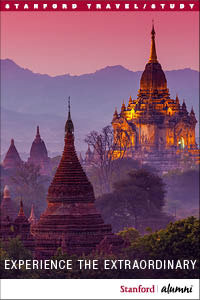Reality Twice Removed
Kota Ezawa's artwork makes even the most familiar images ripe for the double taking.
Photo: Jeffery Cross
ZEITGEIST SURFER: In the hands of German-born animator Ezawa, familiar sources become relatively abstract shapes.
By Jack Fischer
Even among the adventurous denizens of the department of art and art history, it must have seemed an odd preoccupation. Kota Ezawa, MFA '03, spent a year at Stanford redrawing the final three minutes of O.J. Simpson's 1995 murder trial.
Frame by frame on a computer, Ezawa painstakingly rendered the announcement of the stunning not-guilty verdict in the simplified lines and flat colors of a child's picture book. The audio track he left unaltered. The result—something like My Little Golden Book Meets the Crime of the Century—would become The Simpson Verdict (2002), a strangely compelling, three-minute DVD loop that ultimately would be created in an edition of 15.
Since then the artist has explored permutations of this technique across a range of media in works both iconic (the Zapruder footage of John Kennedy's assassination) and banal (no disrespect intended: a portrait of his mother-in-law). Ezawa's versions, while simple on the surface, revitalize well-worn imagery and remind viewers of the usually unacknowledged chasm between reality and the inevitably second-hand depictions media-watchers consume.
With the stylistic breakthrough of the Simpson piece, Ezawa opened a vein of artistic exploration that draws from pop art, abstraction, media art, conceptual art and the work of painter Alex Katz. Ezawa says his original interest in the Simpson piece was formal: how the relatively abstract shapes he was using would affect the way viewers experienced it.
Ezawa is "singular in character and artistic vision," says professor emeritus David Hannah. "His work surfs the zeitgeist with conceptual elegance and simplicity of means. There's always critical alertness and keen intelligence, work unencumbered by the extraneous."
Now an assistant professor of art at the California College of Art in San Francisco, Ezawa grew up in a small town outside Stuttgart, Germany. Soon after high school, he was accepted at the Kunstakademie in Düsseldorf, where he studied with pioneering American video artist Nam June Paik and performance artist Nan Hoover.
"Art school is very different there," Ezawa says in a recent interview in his spartan San Francisco studio in the Mission District. "It's an apprentice/master system, rather than predicated on academic learning." After three years of study there and on Hoover's suggestion, Ezawa emigrated to San Francisco and got a BFA at the San Francisco Art Institute. "The American art scene was a liberation," he recalls. "It's less hierarchical and very empowering. In Germany there is less energy but more prestige. Here artists seem to be harder working and there's more energy."
There followed several years of kicking around the art scene, working at the nonprofit art center New Langton Arts in San Francisco. At the time, he was making short videos with actors. "The amount of work was great but the impact was not," he recalls. "I went to Stanford to reinvent myself as an artist. Being there with the energy of the faculty and the other art students is like a double shot of espresso."
CORRECTION: Praise by David Hannah, art professor emeritus, was inaccurately quoted. He said Ezawa's "work surfs the zeitgeist, with conceptual elegance via simplicity of means. Whatever the particulars of his projects, one will always find critical alertness and keen intelligence, work unencumbered by extraneous itches."
JACK FISCHER is a San Jose writer.
Actions
-
Let Me Introduce Myself
September/October 2008 -
The Menace Within
July/August 2011 -
The Persecution of Daniel Lee
July/August 2011 -
What It Takes
November/December 2013 -
The Effort Effect
March/April 2007








Comments (0)